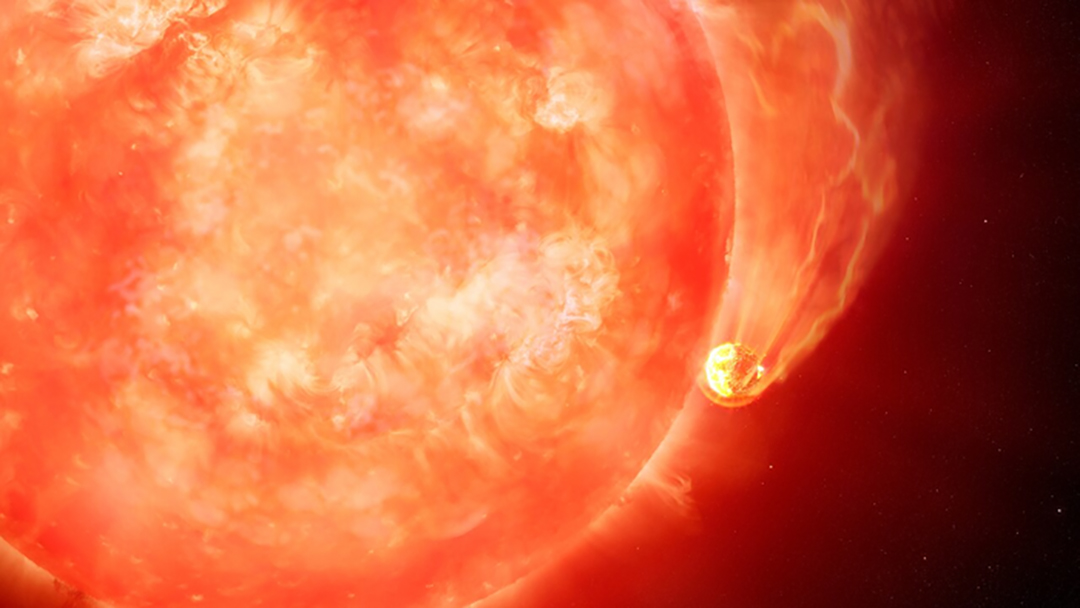Astronomers have seen a distant star make a meal out of a planet in orbit around it. The exoplanet was swallowed by its host star when the stellar body expanded and engulfed it during its “death throes”.
The team behind the observation used the Gemini South Adaptive Optics Imager (GSAOI) on Gemini South, one-half of the International Gemini Observatory, to spot a burst of radiation from the Milky Way’s Galactic disk that they determined came from a star expanding to swallow a planet around ten times the size of Jupiter.
“These observations provide a new perspective on finding and studying the billions of stars in our Milky Way that have already consumed their planets,” co-author of the paper and NOIRLab astronomer Ryan Lau, said in a statement. The team’s research is published in the journal Nature.
The observations have implications closer to home, within our own planetary system, hinting at what will happen to the Earth in roughly 5 billion years. At this point, the sun will enter what is known as its red giant phase, which will see it swell up to as much as 100 times its current size with its diameter reaching out to the orbit of Mars, causing it to obliterate the Solar System’s inner planets.
Stars enter this phase when they run out of hydrogen needed to forge helium during nuclear fusion in their cores. This ends the outward energy that protects the core against collapse caused by the inward pressure of its own gravity. As the core undergoes gravitational collapse, the outer layers of the star are shed as ongoing nuclear fusion in these layers heats this material and causes it to swell outwards. During this red giant phase, a star can expand up to as much as 1,000 its original size.
Astronomers and astrophysicists have long suspected that this process would engulf and destroy planets orbiting close to these stars, but this is the first time this destructive action has been witnessed.
The emission that hints at this destructive process, ZTF SLRN-2020, consists of a short-lived optical outburst followed by a bright and long-lasting infrared emission. The optical outburst lasted around ten days while the infrared finale of the event, designated ZTF SLRN-2020, faded slowly over a much longer period of around six months.
The team was able to determine that ZTF SLRN-2020 was the result of a dying star by developing several models to determine the properties of its source and the astronomical event behind the emissions. One of the key clues came when they eliminated a “red nova”, which is a collision and merger of two stars, as the cause of the emissions. The team determines that the luminosity of ZTF SLRN-2020 wasn’t great enough to account for the collision between two stars.
This led the astronomers to realize that ZTF SLRN-2020 must be the result of a collision and merger between a star and an object somewhat smaller than it, which they eventually determined to be a planet equal to or less than around ten times the mass of Jupiter.
In a Nature News and Views piece accompanying the research paper the University of California Department of Physics and Astronomy, researcher Smadar Naoz, who was not involved in the study, explained how the consumption of this massive planet by its parent star may have progressed.
“A giant planet had ventured too close to its parent star, interacting with it for a while before the outburst, which probably correlated with the engulfment of the planet by the star,” she said.
Naoz noted that the final fate of the planet and the extent to which it was consumed will depend on the conditions of the event, suggesting that future observations of ZTF SLRN-2020 will be needed.
“Such tests will no doubt open up a vast body of investigations of similar events, as well as the mechanisms that drive them,” she concluded.
References: Kishalay De, et al., An infrared transient from a star engulfing a planet, Nature, (2023). DOI: 10.1038/s41586–023–05842-x; Smadar Naoz, Planet swallowed after venturing too close to its star, Nature, (2023).
Feature image credit: International Gemini Observatory/NOIRLab/NSF/AURA/M. Garlick/M. Zamani

















